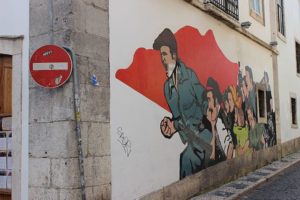
A mural by António Alves and RIGO in Lisbon (photo courtesy of Metro Centric)
The city of Lisbon is commissioning graffiti artists to create new work around the city to commemorate the anniversary of Portugal’s transition to democracy.
Lisbon’s municipal council is seeking to commemorate the fiftieth anniversary of Portugal’s Carnation Revolution, which initiated the country’s transition to democracy after decades of dictatorship. From 1926 to 1974, an autocratic government ruled Portugal. Between 1933 and 1968, the dictatorial prime minister António de Oliveira Salazar led the country. With Salazar’s death in 1968, the government began to weaken, prompting the military to launch a coup on April 25, 1974. With the coup underway, spontaneous popular demonstrations broke out in Lisbon in support of the rebellion. Thousands gathered in the city’s flower market, where carnations were abundant as they were in season. Demonstrators began wearing the carnations on their clothing, while soldiers put the flowers in the barrels of their guns.
Portugal’s transition from dictatorship to democracy is inherently linked with street art. Street art often plays an important role in areas affected by conflict or political turmoil. Northern Ireland, for example, is dotted with murals and graffiti reflecting the many aspects of the sectarian conflict that rocked the country from the 1960s to the 1990s. After the downfall of Portugal’s dictatorship, the country’s streets became colored with murals, slogans, caricatures, and other forms of expression. Much of it was political. Some political parties were well-funded and could print posters and distribute leaflets. Others, particularly leftist parties, had no such funds and turned to street art to disseminate their messages.
Therefore, the municipal council and Lisbon’s Gallery of Urban Art have posed the question, “Where is freedom?” as a prompt for a group of street artists. Representing five decades since the Revolution, five artists will create five original works around the city as an answer. The artists include António Alves, Ines Arisca, Kruella d’Enfer, MaisMenos, and Youth One. Alves is an older street artist, having originally gotten his start in the years leading up to the Carnation Revolution. He initially practiced street art as a form of civil resistance and continues to draw from that tradition by pulling from the aesthetics of Maoist social realist painting. Adalberto Brito, who popularly goes by the name Youth One, has been creating street art since he was a teenager in the late 1980s when graffiti and street art became a recognized art form in Portugal after decades of repression. The progression of YouthOne’s work in Lisbon’s Liberdade neighborhood bordering Monsanto Park is being documented by the artist on his Instagram page. In contrast, Arisca and d’Enfer are relative newcomers to the genre, but their inclusion promises to bring newer, more feminine perspectives on the subject matter.
By inviting a diverse group of artists to offer their take on the same subject, the project helps younger generations with the Carnation Revolution’s continuing legacy. It helps connect people with important historical moments in new and interesting ways. The new, completed murals will be unveiled on September 10th.
